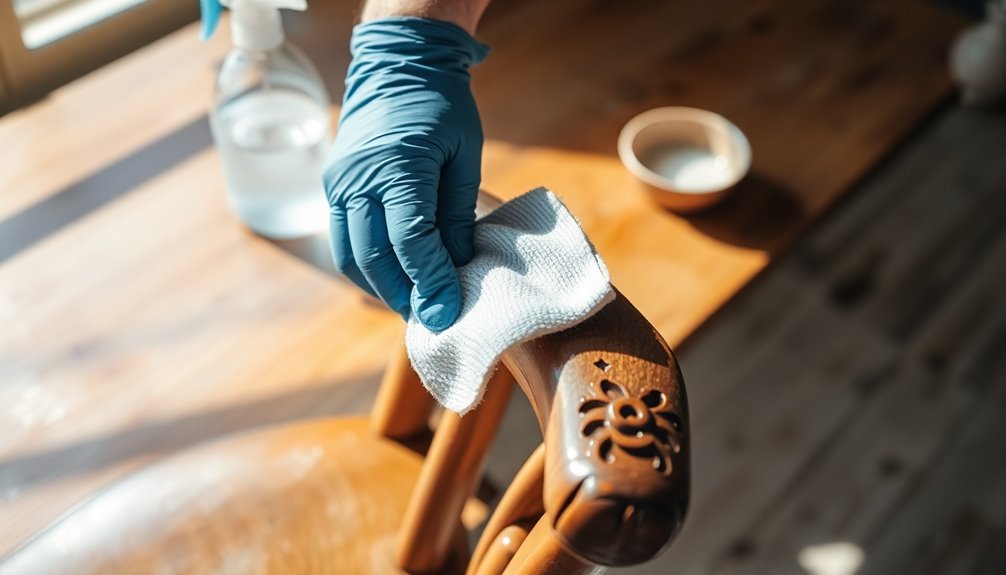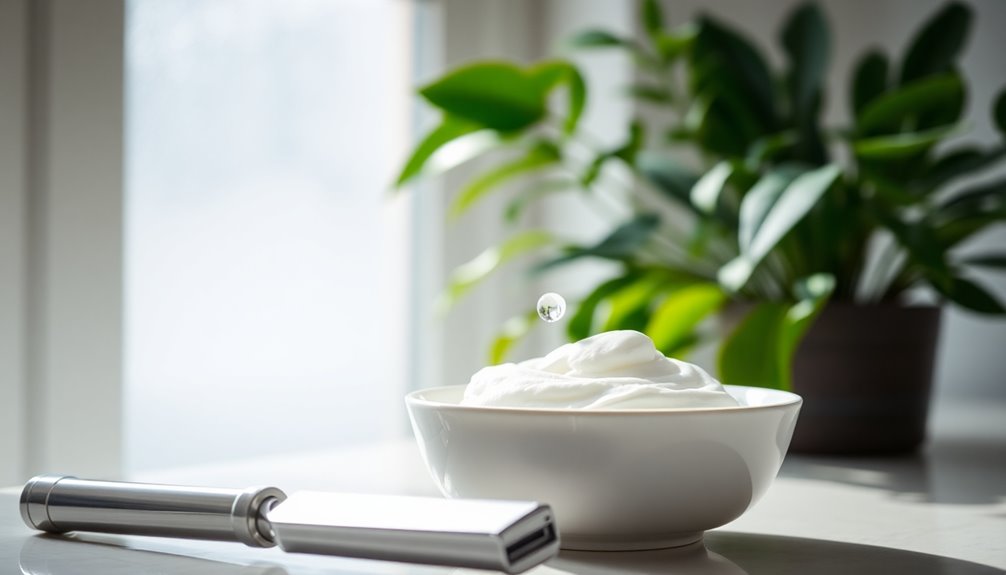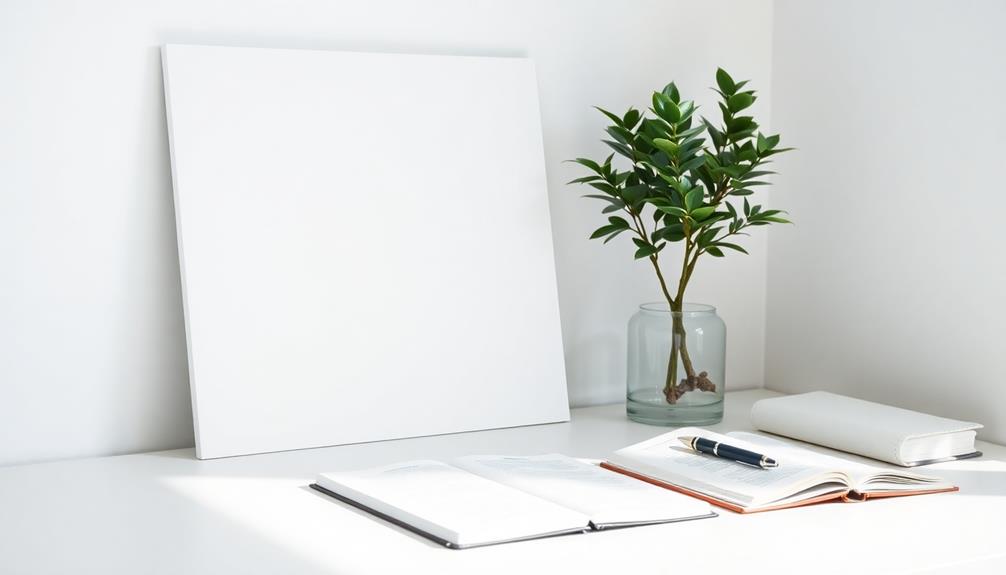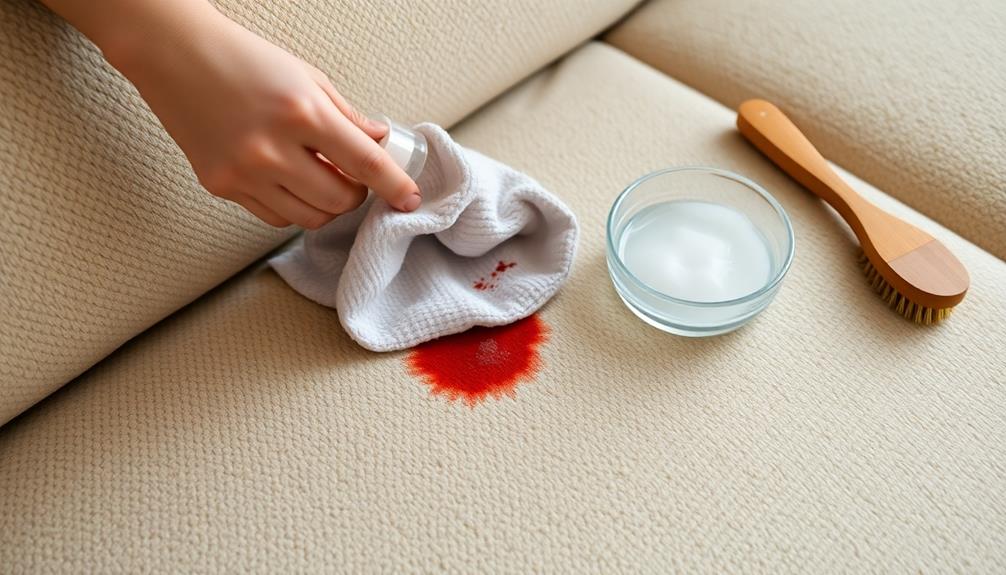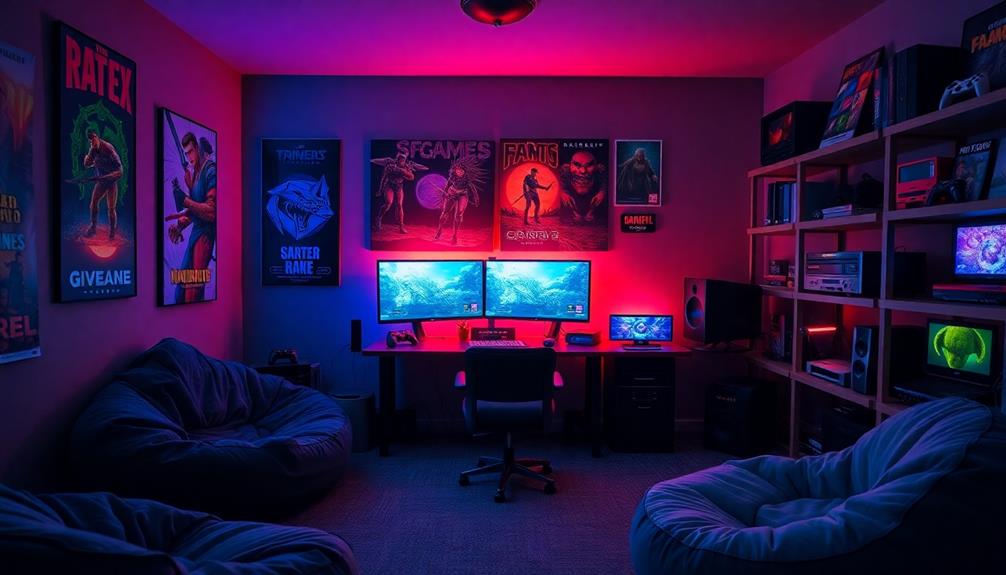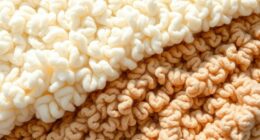To clean used furniture effectively, start by inspecting it for damage, odors, and pests. Vacuum surfaces and sprinkle baking soda to deodorize. For wooden pieces, dust with a damp microfiber cloth and use a mix of water and vinegar for cleaning. Upholstered furniture needs a thorough vacuum and spot treatment for stains. Use natural solutions, like lemon juice and olive oil, to maintain shine on wood, while leather requires conditioning after cleaning. Don't forget to air out furniture to remove lingering smells. If you want to explore specific cleaning methods or tools, there's plenty more to uncover.
Key Takeaways
- Inspect the furniture for damage, odors, and pests before cleaning to assess its condition thoroughly.
- Use a damp microfiber cloth and a natural cleaning solution of equal parts water and white vinegar for wooden surfaces.
- Vacuum upholstered furniture with an attachment, checking tags for cleaning codes and testing solutions on inconspicuous areas.
- Disinfect surfaces using a proper dilution of disinfectant and ensure they are completely dry to prevent damage.
- Regular maintenance, including dusting and using mild cleaning solutions, helps preserve the furniture's quality and appearance.
Assessing and Preparing the Furniture
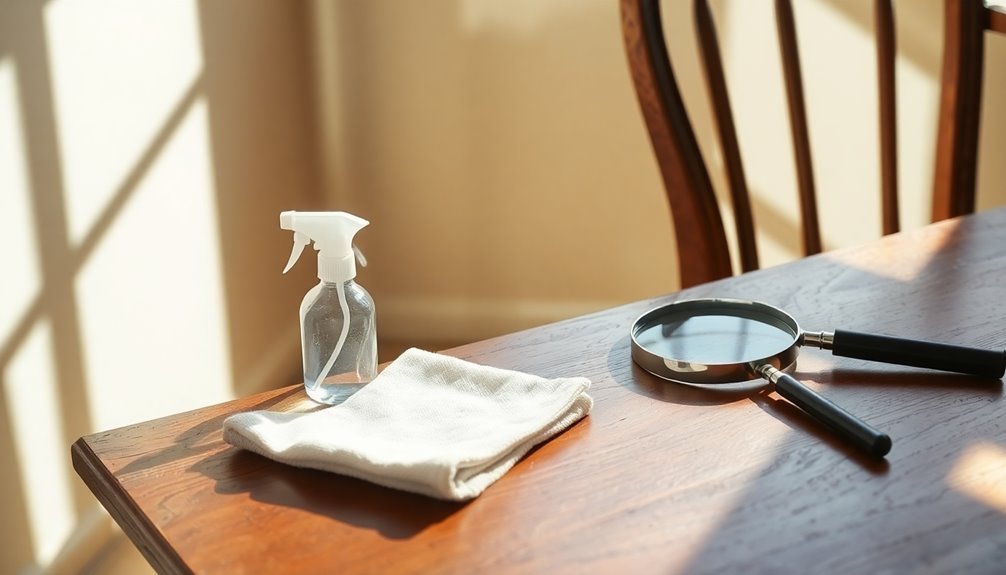
Before diving into the cleaning process, you'll want to kick off by thoroughly assessing and preparing your used furniture. Start by inspecting the piece for any damage or wear; look for scratches, dents, or cracks in wood or metal. If it has upholstery, check for tears, stains, or fading. Make sure drawers and doors open and close smoothly, and look for any missing or broken parts. Testing the furniture's stability by sitting or leaning on it can also reveal underlying issues.
Next, check for pests and odors. Smell the furniture to detect any musty or moldy odors, and look for signs of mold, especially in damp areas. Avoid any furniture that might harbor bed bugs or other pests. Research before shopping can also help identify potential issues associated with specific furniture types.
Evaluate the structural integrity by inspecting joints for looseness, and check for cracks or broken legs. Confirm all parts are present and in good condition.
Finally, prepare the furniture for cleaning. Vacuum to remove dust and bugs, and open drawers to air them out. Sprinkle baking soda inside to deodorize and wipe down surfaces with a soft cloth.
Cleaning Wooden Furniture
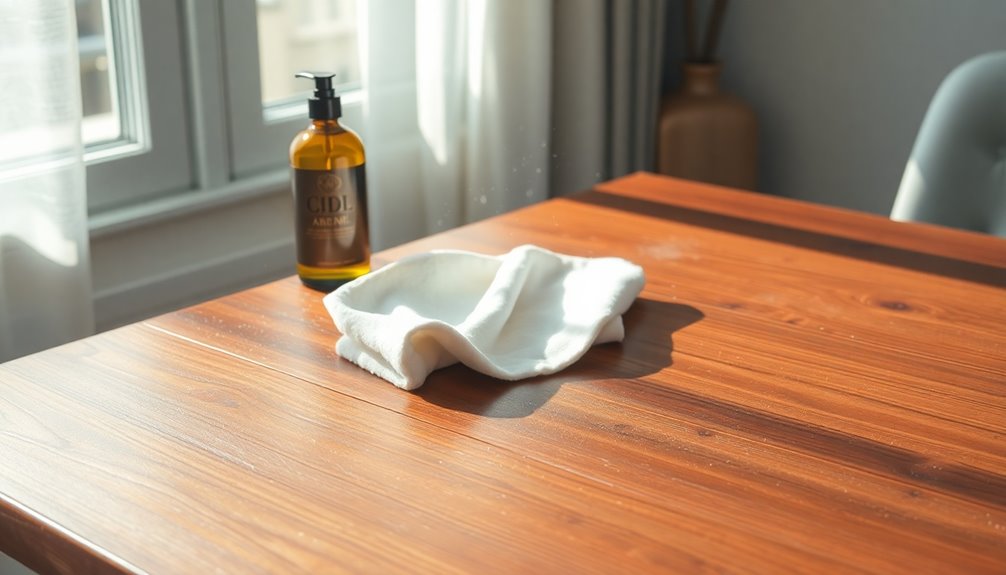
When you're ready to clean wooden furniture, start by dusting it off with a damp microfiber cloth or a soft brush to pick up any loose dirt. Avoid using harsh chemicals or abrasive cleaners, as these can damage the finish. For a natural cleaning solution, mix equal parts of water and white vinegar in a spray bottle. This blend effectively dissolves dirt and sticky residue.
If you need a deeper clean, use a mixture of mild dish soap and warm water. Apply it gently, making sure to rinse and dry afterward. For stubborn stains, create a paste with baking soda and water, apply it, let it sit, and then wipe it off with a damp cloth. Remember that teak wood is ideal for outdoor furniture due to its durability, which can influence your cleaning approach depending on the type of wood.
To maintain your furniture's shine, consider using a paste made from lemon juice and olive oil, which disinfects and nourishes the wood. After cleaning, dry the surface with a clean, absorbent cloth, following the wood grain. Finally, apply a suitable furniture polish or wax to enhance the wood's natural beauty and protect it from future damage. Regular maintenance will keep your wooden furniture looking its best.
Cleaning Upholstered Furniture
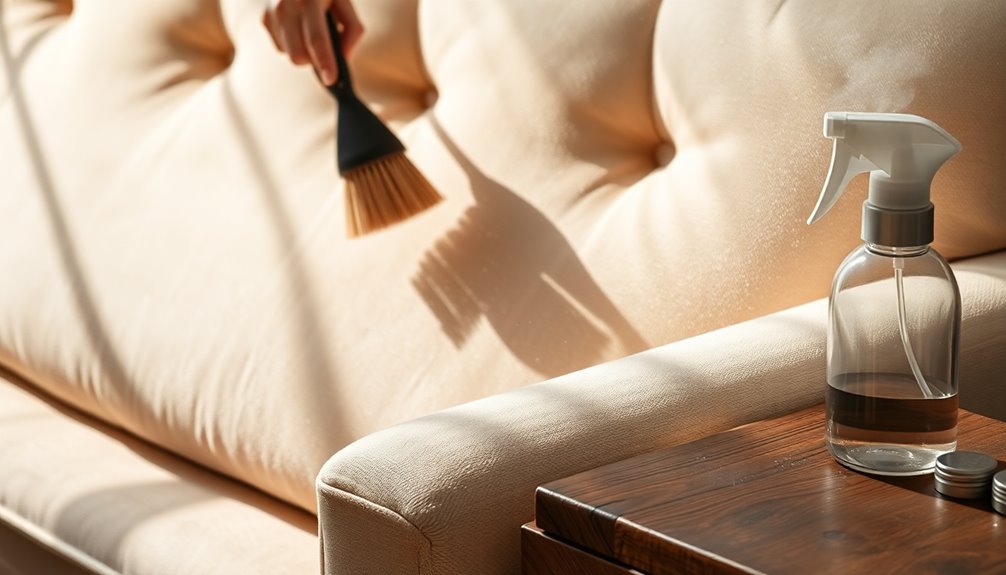
Cleaning upholstered furniture can seem daunting, but with the right approach, it's a manageable task. Start by vacuuming thoroughly with an upholstery attachment to eliminate dust and pet hair. Don't forget to check the furniture tag for cleaning codes to guide your process. Test any cleaning solution on an inconspicuous area first to avoid damage.
Next, use a dry brush to remove residue and fluff the fabric fibers. For solid stains like mayonnaise, gently lift them away using a dull knife or credit card. For general cleaning, mix 1 teaspoon of dishwashing liquid with 1 gallon of warm water, and apply it to the fabric. When dealing with stains, a watered-down laundry stain remover works well. Regular cleaning enhances the visual appeal of furniture and contributes to a healthier living environment by preventing the buildup of allergens and dust mites.
Blot stains with a microfiber cloth, and avoid rubbing, which can spread the stain. If needed, scrub the area with a soft-bristled brush. You can use a spotter machine to extract dirt and cleaner effectively. Once done, rinse the area with clear water, blot dry, and sprinkle baking soda to absorb any lingering odors. Regular maintenance, like vacuuming and inspecting the upholstery, will keep your furniture looking fresh.
Using Natural Cleaning Solutions
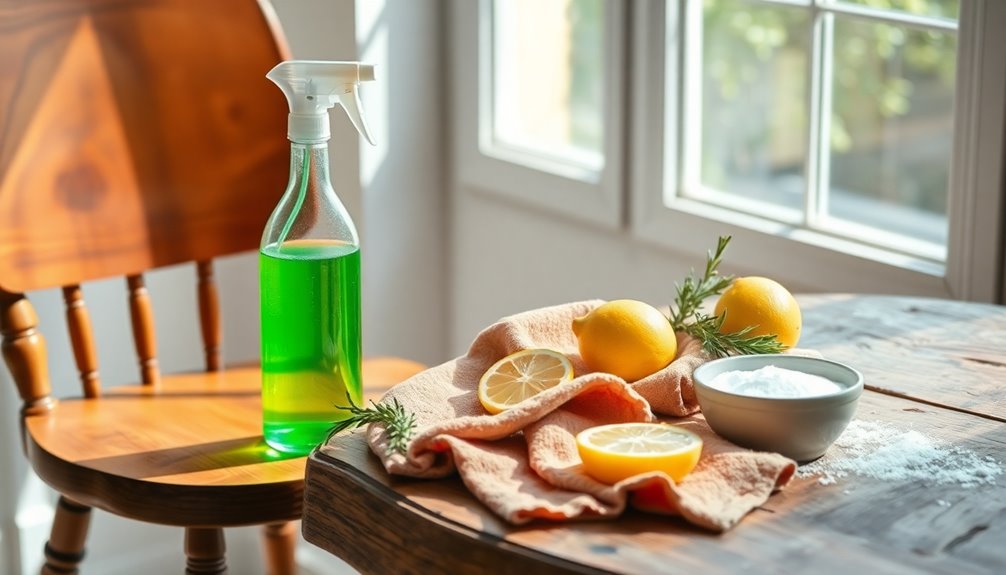
Harnessing the power of natural cleaning solutions offers an eco-friendly alternative for maintaining your used furniture. You can start with white vinegar, which effectively removes stains, odors, and grease from various materials. For wood and leather, lemon juice mixed with olive or jojoba oil works wonders as a polish. Baking soda is great for tackling odors and stains; just mix it with water and mild soap to create a cleaning paste.
Essential oils not only add a lovely fragrance but also provide natural antibacterial properties—lavender, tea tree, and lemon are excellent choices. Olive oil can nourish wood and leather surfaces when combined with your cleaning solutions. Regular use of natural products can significantly extend the lifespan of your furniture, ensuring it stays looking great for years to come.
When cleaning, use gentle scrubbing techniques with microfiber cloths or soft-bristle brushes to avoid damage. Steam cleaning with water and white distilled vinegar can freshen and sanitize your furniture effectively. Make sure to remove all residual cleaning agents afterward to keep your furniture safe.
Finally, test any solution on a small, inconspicuous area first to avoid surprises. By using these natural solutions, you ensure a cleaner environment for both your furniture and your home.
Specialized Cleaning for Materials
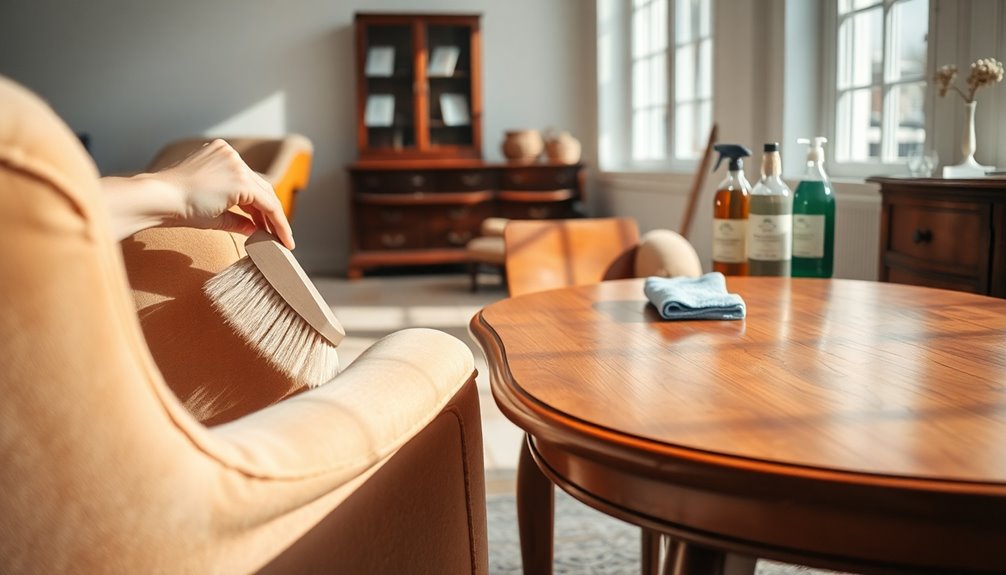
Different upholstery materials require specialized cleaning techniques to ensure they remain in great condition. For fabric upholstery, start by vacuuming all surfaces with a HEPA filter vacuum to capture dust and allergens. After that, steam clean the fabric, using a mild detergent solution for optimal results. When dealing with stains, remember to blot fresh liquid spills and gently lift solids with a dull knife—never rub the area.
For leather upholstery, use a mild cleaning solution and lint-free cloths for cleaning. Conditioning the leather afterward helps maintain its quality and luster, so don't skip this step. Avoid harsh chemicals to prevent damage, as proper care methods are crucial for preserving the leather's appearance.
Suede and leatherette need special care; use dry-cleaning tools for suede and a gentle detergent for leatherette. Always test any cleaning solution on a hidden area first.
Vinyl and synthetic upholstery can be cleaned with a damp cloth and a suitable cleaner. Rinse with plain water to remove excess solvent and maintain longevity. Regular cleaning keeps vinyl furniture looking great, while avoiding abrasive agents will help preserve its surface.
Disinfecting Furniture Surfaces
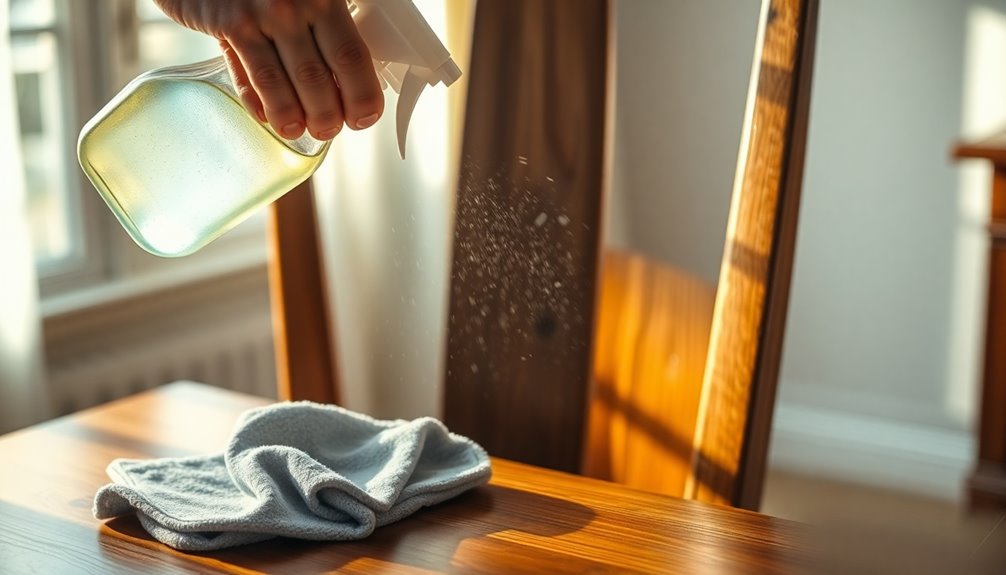
Disinfecting Furniture Surfaces
After ensuring your furniture is clean, the next step is disinfecting surfaces to eliminate germs and create a healthier environment. Start by mixing a mild solution of water and detergent, using a ratio of 4 parts water to 1 part soap or detergent. Dampen a lint-free cloth and wipe down surfaces, particularly wood, always following the grain. Avoid soaking wood and metal pieces; instead, dry them thoroughly with a soft cloth.
For effective disinfection, you can use a bleach solution (1 part bleach to 32 parts water) or a 3% hydrogen peroxide solution. Isopropyl alcohol (70% diluted) also works well. If you prefer convenience, try Lysol Disinfecting Wipes or Clorox NON BLEACH Wipes. Remember to rinse with clean water after using any disinfectant. Additionally, when using Pine-Sol for disinfection, it's important to follow the correct dilution ratios to ensure both effectiveness and safety.
When disinfecting wood surfaces, mix Pine-Sol with water, using ⅛ cup per gallon for cleaning or 1 cup per ½ gallon for disinfection. Always test your disinfectant on an inconspicuous area first and wear gloves to protect your skin. Finally, ensure surfaces are completely dry to prevent damage.
Removing Stains and Odors
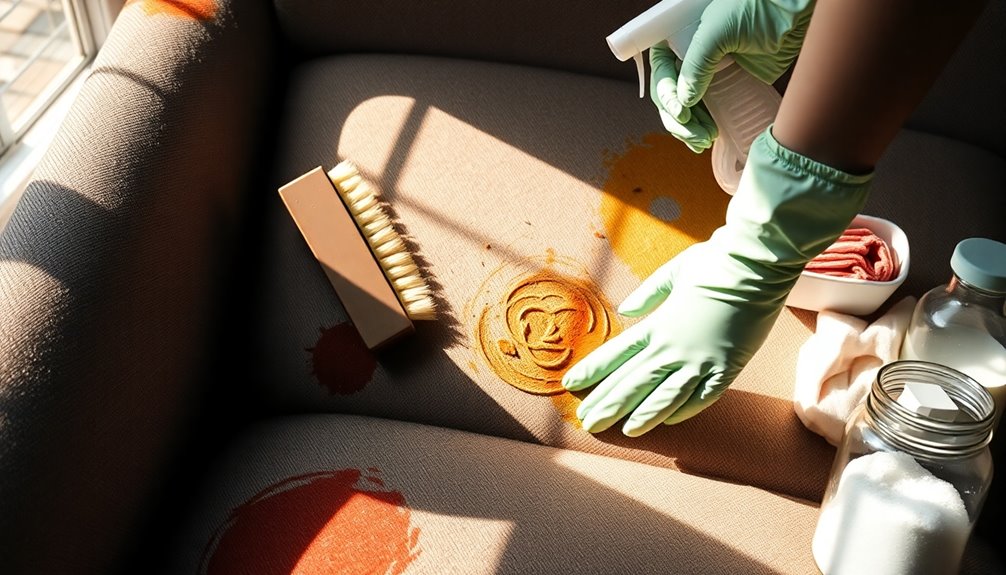
Stains and odors can significantly diminish the appeal of used furniture, but tackling them effectively can restore its charm. Start by addressing stains with various methods. For chemical options, try applying CitriStrip Stripping Gel, covering it with plastic wrap, and scrubbing it off after 30 minutes. You can also use mineral spirits or denatured alcohol on a damp rag to rub the stain gently. For natural solutions, mayonnaise can be dabbed and rubbed in circles over the stain, while a mixture of vinegar and olive oil can work wonders if left on for a few hours. Additionally, after using CitriStrip Stripping Gel, make sure to allow the wood to dry completely before further treatment.
Next, focus on odors. Airing out the furniture by opening drawers or cabinet doors in sunlight can help eliminate musty smells. Sprinkling baking soda inside drawers will absorb odors overnight. You might also want to vacuum and clean the furniture to remove dust and particles contributing to unpleasant smells. For a final touch, consider using an odor-absorbing spray to freshen things up. By effectively removing stains and odors, you'll enhance the beauty and longevity of your used furniture.
Tools and Supplies Needed

Cleaning used furniture effectively requires a few essential tools and supplies. Start with cleaning solutions like white vinegar, mild dish soap, and lemon essential oil. For upholstery, consider Woolite Fabric & Upholstery cleaner or Charlie’s Soap. A vacuum cleaner performance is crucial for ensuring the removal of dust and allergens. When cleaning furniture, it’s important to pay attention to the specific needs of different materials. For instance, if you’re unsure how to clean antique furniture, it’s best to use gentle methods that won’t damage the finish. Additionally, always test any cleaning solution on a small, inconspicuous area first to ensure it won’t negatively affect the surface. Regular maintenance, such as dusting and applying a protective polish, can also help keep your furniture looking its best.
You'll need some robust cleaning tools, too. A vacuum cleaner, especially one with a brush attachment, is invaluable for removing dust and debris. Keep soft and microfiber cloths handy for gentle wiping. Hard bristle brushes and SOS Steel Wool Pads help tackle tougher grime. A spray bottle is perfect for applying your cleaning solutions.
Don't forget specialized products. Baking soda can work wonders for odors, while Goo-Gone is great for sticker residue. Nail polish remover can help with permanent markers, and hemp oil hydrates old wood and polishes metal. Additionally, using thrift store furniture can often be a cost-effective alternative to purchasing new pieces.
Gather miscellaneous supplies like water, sandpaper, and sunshine to air out the furniture. Protective gear such as gloves and a respirator mask can keep you safe from dust and chemicals. Lastly, a drill and screwdriver are handy for disassembling and reassembling furniture as needed. With these tools and supplies, you're ready to tackle your used furniture cleaning project!
Drying and Finishing Touches
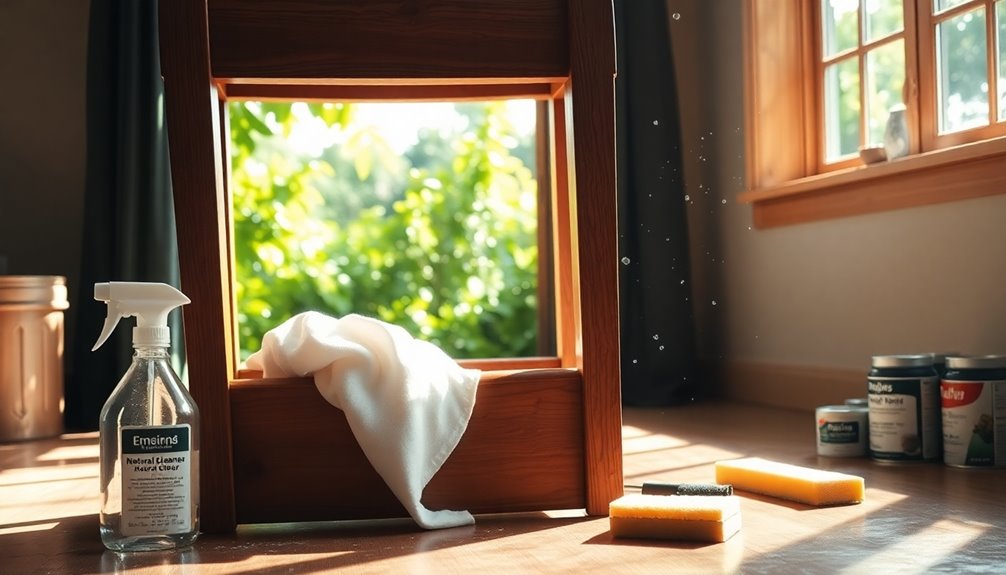
Once you've cleaned your used furniture, it's essential to focus on drying and applying the finishing touches to ensure it looks its best. You have two main drying methods: natural and artificial. If you choose natural drying, stack the wood in a clean, cool, dry, and shady place, allowing for good air circulation. However, this method can take months or even years, depending on the climate. On the other hand, artificial drying, using heat in controlled conditions, is faster and reduces risks like warping. This method is especially beneficial for teak wood, as it significantly reduces drying time compared to natural drying.
After drying, inspect the furniture thoroughly. Check for moisture content; it should ideally be between 6% and 12%. If needed, make adjustments for any signs of warping or cracking. Seal the cut ends with a commercial wood sealer or a mix of wax and paint to maintain wood integrity and prevent moisture loss. Finally, apply the appropriate finish based on how you plan to use the furniture. This final touch not only enhances the appearance but also protects the wood, ensuring your furniture is ready for use and looks fantastic in your home.
Maintenance Tips for Clean Furniture
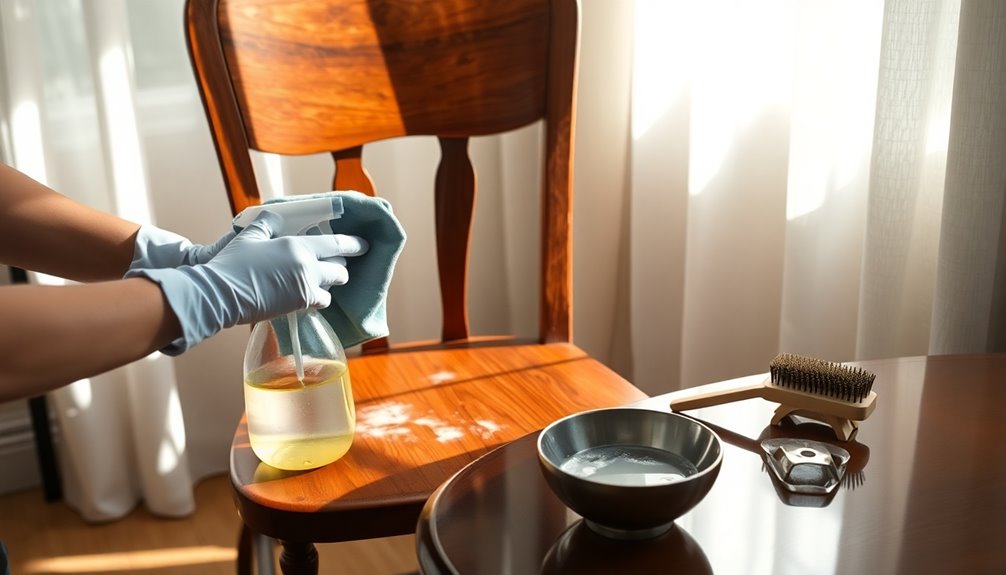
To keep your used furniture looking its best, regular maintenance is key. Start by dusting and vacuuming at least every other week. Use a soft, dry cloth or brush to dust all surfaces, including the back and underside. Vacuum upholstery and all nooks and crannies to remove dust, dirt, and any critters that may have made themselves at home.
For cleaning, stick to a mild soap solution and a soft cloth. A mix of warm water, vinegar, and a few drops of dish soap works wonders for disinfecting. Avoid harsh chemicals and abrasive cleaners that could damage your furniture. Remember to frequently dust to protect the finish from grit and dirt build-up.
Protect your pieces by keeping them out of direct sunlight and using coasters and placemats. Trivets are a must for hot dishes to prevent heat damage.
After cleaning, polish your furniture to restore its shine—just be sure to use a polish low in alcohol. Apply it sparingly to avoid build-up. Finally, check for any repairs needed, like loose legs or broken hinges, to keep your furniture in top shape. Regular maintenance goes a long way in preserving the beauty of your used furniture.
Frequently Asked Questions
How Often Should I Clean Used Furniture?
You should clean your furniture based on how often it gets used. For high-traffic areas, aim for every 6-12 months, while less-used spaces can stretch to 12-18 months. If you have pets or kids, you'll want to clean more frequently due to spills and allergens. Regular vacuuming is key, especially for fabric sofas. Don't forget to address spills immediately to prevent stains from setting in, keeping your furniture looking fresh and clean.
Can I Use a Steam Cleaner on All Fabrics?
You can't use a steam cleaner on all fabrics. While materials like cotton, polyester, and microfiber respond well to steam cleaning, others like leather, silk, and suede can get damaged. Always check the manufacturer's care label first. It's smart to test a small, hidden area before proceeding. Remember to avoid over-wetting and use the right attachments for best results. Regular maintenance keeps your upholstery looking fresh and clean.
Is It Safe to Use Bleach on Furniture?
Using bleach on furniture can be risky. It's crucial to understand the fabric type first. Natural fibers like cotton and wool can get damaged, while synthetic fibers are more resistant. Always test a small, hidden area before applying bleach. Dilute it properly, and never leave it on too long. If you're unsure, consider safer alternatives like disinfecting mists or color-safe cleaners to avoid potential damage and discoloration.
How Can I Prevent Future Odors in Furniture?
To prevent future odors in your furniture, keep a regular cleaning routine. Vacuum upholstery often and wipe down surfaces to remove dust. Use fabric protectors to repel stains and odors, and address spills immediately. Ensure good airflow by opening windows and using exhaust fans. If you have pets, clean their messes right away and consider furniture with washable covers. Lastly, maintain optimal humidity levels to discourage mustiness and mold.
What Should I Do if My Furniture Has Mold?
If your furniture has mold, start by identifying the type and checking for moisture. Wear protective gear like gloves and a mask, then move the furniture to a ventilated area. Vacuum with a HEPA filter to capture loose spores. Apply a cleaning solution—water with detergent for light mold, or vinegar for a gentler option. Scrub gently, rinse thoroughly, and let it dry completely to prevent future growth. Regular inspections can help catch mold early.
Conclusion
Cleaning used furniture doesn't have to be daunting. By assessing the materials and using the right techniques, you can bring new life to your pieces. Don't forget to tackle any stains or odors with effective solutions, and always let your furniture dry properly to avoid damage. With regular maintenance, your furniture will not only look great but also last longer. So roll up your sleeves, and enjoy the process of transforming your space!
